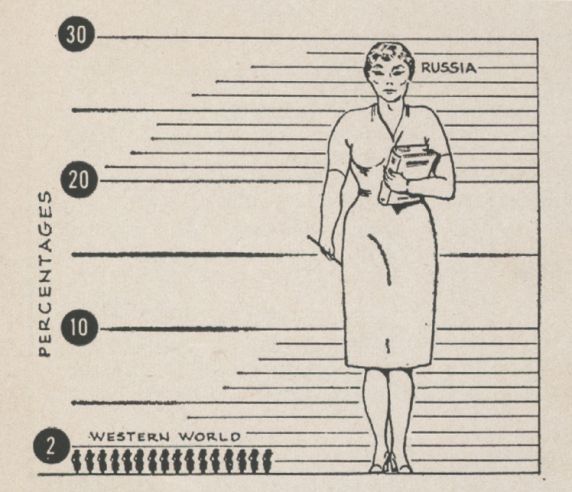Harnessing Engineering Womanpower in the Cold War
In 1955, in the midst of the Cold War, the U.S. Department of Labor Women’s Bureau hosted a Conference on the Effective Use of Womanpower. The Department of Labor was worried that the United States was producing too few engineers and scientists as compared to the number produced in the U.S.S.R., and found that the recruitment and training of women in science and engineering fields could help to alleviate the disparity. Indeed, at the time the U.S.S.R. had the highest percentage of woman engineers in the world, with 36% of all its scientific research workers being women. As a point of comparison, less than 7% of scientists in America were women, and women made up less than 1% of the American engineering workforce.
In his welcoming address, U.S. Secretary of Labor James P. Mitchell noted that 20 million women -- about one-third of all wage earners – were working in the United States. Mitchell argued, “The demand for women’s services has been growing at a rapid rate. It will continue to grow as our labor force strives to meet the increasing demands made upon it by this turbulent age. Women will be asked in the future to fill new jobs – jobs they have little chance of obtaining today. It is our duty to plan now for the wise use of womanpower in the future. In this respect, it must be remembered that there are an additional 11 million women between the ages of 18 and 64 available for work, in the event that our economy has to expand in a hurry.”
Members of the Society of Women Engineers were hopeful that their employment opportunities would improve with this new call for engineering and scientific womanpower. Six years later, however, society’s attitudes continued to bind women engineers’ options. An article published in the March 1961 issue of Industrial Relations News, and reprinted in the March 1961 issue of the SWE Newsletter, reported that “In the face of a severe shortage of engineers, one study of male executives indicates 81% wouldn't hire female engineers, and most of the remaining respondents would be dead set against permitting them to reach middle-management levels.” Among the reasons listed for this reluctance included women’s higher rate of absenteeism due to illness and family responsibilities, sensitivity to criticism, lesser loyalty to their companies, and disinterest in their jobs due to lower wages and expectations.
While the 1964 Civil Rights Act prevented employers from overtly refusing to hire women, it was difficult to overcome managers’ more subtle biases against women engineers. By offering professional guidance and development opportunities, SWE worked quietly in the 1960s to empower women in such a male-dominated field. For example, the 1961 SWE Eastern Seaboard Conference featured a panel session on “Widening Horizons for the Professional Woman.” The SWE Newsletter instructed women how to build names for themselves by publishing technical papers. A joint conference hosted by SWE and the University of Pittsburgh in 1962, “The Role of Women in Professional Engineering,” offered rebuttals to arguments against hiring woman engineers. At the conference Harold B. Maynard of the Maynard Research Council argued, perhaps questionably, that women engineers to succeed despite social biases. "There is a certain amount of truth in these and other negative considerations,” Maynard admitted, “but when did a few difficulties ever stop a woman once she had made up her mind about what she wanted.”
The effort to increase engineering and scientific womanpower in the Cold War paid off, with the percentage of women pursuing science and engineering careers increasing exponentially in the late 1960s and 1970s, aided in great part by the burgeoning Women’s Movement which encouraged women to seek employment outside the home. The April 1981 issue of the Engineering Manpower Bulletin reported that while the percentage of engineering bachelors degrees awarded to women was just 0.83 percent in 1970, that number increased to 2.3 percent in 1975, and 9.7 percent in 1980.
Despite the rapid increase in women engineering students in the 1970s, progress has been slow since the 1990s, and has even backtracked over the past decade. The National Center for Science and Engineering Statistics reports that in 2010 women received 18.5 percent of all engineering bachelors degrees awarded in the United States, down from a high of 20.9 percent in 2002. In 2011 women made up just 11.7 percent of the engineering workforce. In recent years, the Society of Women Engineers and other organizations have published a number of studies that find subtle gender discrimination continues to push women away from engineering careers, while at the same time they are being pulled toward other professions. With another national shortage of science, engineering, and technology professionals, leaders are once again wondering how to harness womanpower.
More information on the nation’s quest for scientific womanpower in the 1950s and 1960s can be found in the Society of Women Engineers National Records. For a comparison, the International Conference of Women Engineers and Scientists Records include reports on women’s participation in engineering in other countries during the 1960s.
Troy Eller is the Archivist for the Society of Women Engineers.
- teller's blog
- Login to post comments
- Printer-friendly version


 Reddit
Reddit Facebook
Facebook LinkedIn
LinkedIn